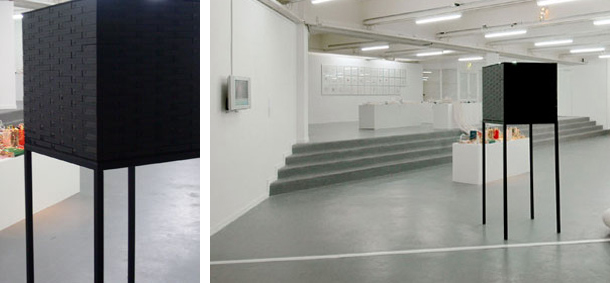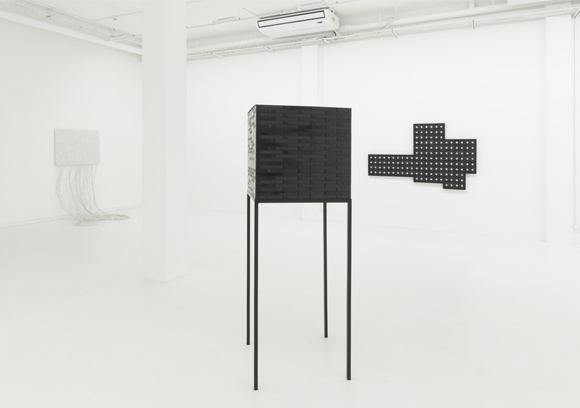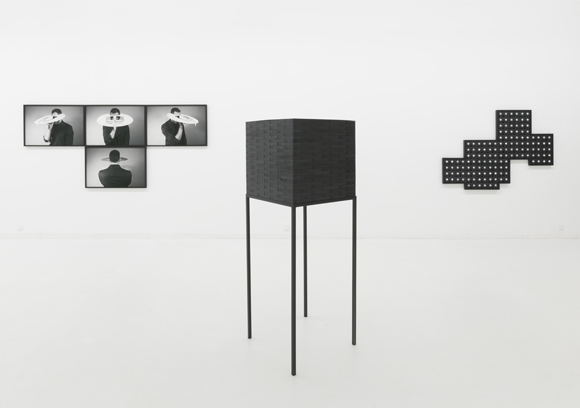| |
|
|
10.
| Propaganda |
| |


2003-2004. VHS, pedestal in metal, 67 x 189 x 67 cm.
Exhibition view from Comprendra bien qui comprendra le dernier, CAC Le Parvis, 2004, Ibos.
Courtesy of the artist and Ceysson & Benetiere, Paris.
Ed. of 5 + 1 A.P.
''This enigmatic Kaaba-like structure, not only critiques the maddening maelstrom that is the digital, the frenetic pace of progress, the industrial collapse, the alienating fierce capitalism and unbridled consumerism, but it
also contains less obvious perspectives that appeal against certain institutions, conventions and norms, to religion and politics, to information, to their ill-affected manipulation and to that sibylline post-truth that tries to condition our movements.''
Fernando Gómez de la Cuesta, March 2021

Propaganda
Exhibition view from The Observer Effect, ADN Galeria, 2021, Barcelona.
Courtesy of the artist.

Propaganda
Exhibition view from The Observer Effect, ADN Galeria, 2021, Barcelona.
Courtesy of the artist.

Propaganda
Exhibition view from Comprendra bien qui comprendra le dernier, CAC Le Parvis, 2004, Ibos.
Courtesy of the artist.
|
|
|
|
|
|
Propagande est une sculpture réalisée à partir de K7 VHS empilées les unes sur les autres et constitue une sorte de cube noir. L’utilisation d’un matériau, bientôt devenu obsolète à l’ère de la numérisation, interroge la fin de l’œuvre elle-même mais surtout une certaine idée de l’absence de l’image.
Telle une boîte de Pandore dont les secrets sont bien gardés, cette sombre architecture se présente comme une entité satellitaire et auto-suffisante à laquelle il est difficile d’avoir accès et qui reste pourtant le principal prescripteur de l’information dans certaines sociétés. L’artiste critique ainsi un système de sécularisation et d’instrumentalisation de l’image qui encourage le prosélytisme et annihile les consciences. Comment construire les modalités d’un meilleur vivre ensemble avec l’image ? Serait-ce une gageure de croire qu’une image peut-encore faire sens alors que des idéologies différentes en génèrent au quotidien? Finalement, qu’est ce qui distingue information et désinformation ? Puisque « Dieu s’est fait verbe », le pouvoir religieux, du haut de sa tour de Babel, institutionnalise l’iconoclasme à une époque où chacun de nous devrait pouvoir disposer des moyens techniques d’être un homo communicans.
Dans cette interprétation d’un motus vivendi radical et religieux, chaque K7 est le tiroir d’une nouvelle doctrine propagandiste et l’édifice tout entier se lie en filigrane d’une architecture à renverser afin d’entamer une vraie archéologie de l’image.
Studio Fatmi, Octobre 2003. |
|
Propaganda is a sculpture made of VHS tapes piled up on top of each other, creating a sort of black cube. The use of a material becoming obsolete in our digital age questions the expiration of the artwork itself but mostly has to do with a certain idea of the absence of images.
Like a Pandora’s box whose secrets are well kept, this dark architecture presents itself like a satellite entity, which is self-sufficient and hard to access, yet remains the main vehicle for information in certain societies. The artist criticizes here a system of secularization and exploitation of images that encourages proselytism and annihilates consciences. How is it possible to construct a society where people would coexist more peacefully with images? Is it unrealistic to believe that an image can still convey meaning when so many different ideologies generate images every day? Finally, what distinguishes information for disinformation? Since “God revealed himself in His word”, religious powers, from the top of their tower of Babel, institutionalize iconoclasm in an era where each of us should have the technical means to become a “homo communicans”.
In this interpretation of a radical and religious modus vivendi, every tape is a drawer for a new propagandist doctrine and the entire edifice is implicitly connected to an architecture that must be overthrown in order to begin a true archeology of images.
Studio Fatmi, October 2003. |
|
|
|